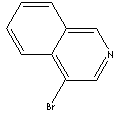| Quinoline,
1-azanaphthalene,
is an aromatic nitrogen compound
characterized by a double-ring structure contains a benzene fused to pyridine
at two adjacent carbon atoms.
(Pyridine is a ring structure compound of five carbon atoms with a nitrogen
atom). Quinoline itself
is the simplest member of the quinoline. It is a hygroscopic, yellowish oily liquid;
slightly soluble in water, soluble alcohol, ether, carbon disulfide
and readily in many organic solvents.
It can be obtained
by the distillation
of coal tar. Quinoline can be prepared from aniline with acrolein under heated
sulfuric acid (Skraup synthesis). Various quinoline
compounds can be prepared by Skraup synthesis series
of different oxidizing agents.
Isoquinoline differs from quinoline in
nitrogen position (at 2). Quinoline family compounds are widely used as a parent
compound to make drugs (especially anti-malarial medicines), fungicides,
biocides, alkaloids, dyes, rubber chemicals and flavoring agents. They have
antiseptic, antipyretic, and antiperiodic properties. They are also used as
catalyst, corrosion inhibitor, preservative, and as solvent for resins and
terpenes. They are used in transition-metal complex catalyst chemistry for
uniform polymerization and luminescence chemistry. They are used as antifoaming agent
in refinery field. Quinaldine,
2-methylquinoline,
is used as an
anti-malaria and preparing other anti-malaria drugs.
It is used in manufacturing oil soluble dyes, food
colorants, pharmaceuticals, pH indicators and other
organic compounds. Quinaldic Acid is
a carboxylic acid substituted quinoline at 2 position,
a catabolite of tryptophan (aromatic side chain amino
acid). Quinazoline,
diazanaphthalene at 1,3 positions,
is used
as a chemical intermediate for making medicines and
other organic compounds. It is a fundamental structure
in some antihypertensive
agents such as prazosin and doxazosin which are peripheral vasodilator.
Quinoxaline, diazanaphthalene
at 1,4 positions, is used as a chemical
intermediate for making fungicides and other organic compounds. |
